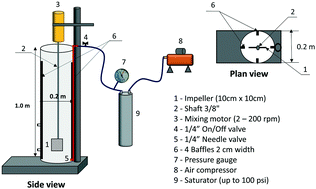Large batch bench-scale dissolved air flotation system (LB-DAF) for drinking water treatability tests
Abstract
The feasibility of dissolved air flotation (DAF) for water treatment is frequently assessed by bench-scale tests using commercially available 1–2 L volume DAF jar test apparatuses. However, they can over-predict or under-predict turbidity removal. It is hypothesized that, similar to flocculent settling tests, larger diameter vessels will improve the DAF batch test predictions. Thus, the main objective of this research was to develop and test a larger diameter/larger volume (∼21 L) batch bench-scale DAF system (LB-DAF). A sensitivity analysis of the impact of the LB-DAF saturator pressure (SP), recycle ratio (RR), water depth to tank diameter ratio (D/W), impeller type and velocity gradients (G) was conducted to identify the values that yielded the best simulations of a full-scale DAF system. For the low turbidity, high organics river water tested, the LB-DAF system simulated the full-scale DAF turbidity removal much better than the DAF jar tests. This was in part due to the LB-DAF tank's saturated water delivery system and its larger vessel diameter. The values of the LB-DAF design/operational parameters had a relatively small impact on turbidity and natural organic matter (NOM) removals, so there was no single optimal set of LB-DAF operating conditions. NOM removal in the LB-DAF, the DAF jar and the full-scale DAF systems was very similar.



 Please wait while we load your content...
Please wait while we load your content...